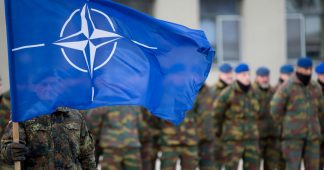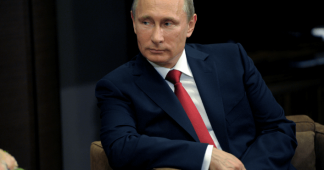By Andre Damon
Jun 9, 2023
This week, Ukraine launched its long-planned offensive against Russian-occupied territory, throwing armored columns, including NATO-supplied main battle tanks, against entrenched Russian positions.
According to information provided by Russian officials, which has not been contradicted by the Ukrainian government, the initial offensive has resulted in a series of military debacles for the Ukrainian armed forces.
The Russian Ministry of Defense released footage of columns of Ukrainian armor, apparently advancing without air cover in open fields, with disastrous results. The footage also depicted the destruction of a German Leopard 2 battle tank, according to the Russian government.
On Thursday, Russian Defense Minister Sergei Shoigu said that Ukrainian forces attempted to launch an attack near Zaporizhzhia but were repelled, losing 30 tanks, 11 armored fighting vehicles and 350 soldiers. He said Ukraine had lost over 1,000 troops over the course of 24 hours.
Later in the day, the New York Times wrote that US officials “confirmed that advancing Ukrainian troops had suffered casualties in the early fighting,” effectively conceding the truth of the Russian claims.
For months, the coming offensive had been hailed in the US media as a turning point in the war. Bret Stephens of the Times hoped it would bring “a crushing and unmistakable defeat” to Russia, while David Ignatius in the Washington Post said it would “turn the tide” in the war, proclaiming, “D-Day dawns for Ukraine.”
Given the belief of the US-NATO powers that the offensive would produce a staggering defeat for the Russian government, one purpose was to set the stage for the upcoming July 11-12 NATO summit in Vilnius, Lithuania.
The meeting in Vilnius was conceived of as a summit of victors, in which the battlefield successes of Ukraine would serve as the basis for a whole series of ultimatums to Russia, including a full withdrawal not only from portions of Ukraine seized during the 2022 invasion, but also from the Crimean peninsula.
These demands, made by the mobilized NATO forces, bristling with pre-positioned weapons along a massively extended border with Russia (following the accession of Finland to NATO), were to be backed up with the threat of force from a position of strength, aiming to impose a victors’ peace.
Should the Vilnius summit take place under conditions of major setbacks and even a breakdown of the offensive, as at this points appears more likely, it will become the occasion for a massive further escalation of US-NATO involvement in the war.
What was conceived of as a summit of victors may prove to be a summit of desperate governments prepared to take the most reckless actions to reverse the outcome of the war.
In the event of a military debacle for Ukraine, there exists the extreme danger that the NATO powers will respond with the declaration that they will implement a no-fly zone over Ukraine, involving NATO warplanes attacking Russian aircraft, and the deployment of ground troops from NATO member states into Ukraine.
This is the context within which former NATO Secretary-General Anders Rasmussen said that if NATO did not adopt some sort of formal military alliance with Ukraine at the upcoming summit, some NATO members would announce the deployment of their own ground troops.
“If NATO cannot agree on a clear path forward for Ukraine, there is a clear possibility that some countries individually might take action. We know that Poland is very engaged in providing concrete assistance to Ukraine. And I wouldn’t exclude the possibility that Poland would engage even stronger in this context on a national basis and be followed by the Baltic states, maybe including the possibility of troops on the ground.”
He continued:
“I think the Poles would seriously consider going in and assemble a coalition of the willing if Ukraine doesn’t get anything in Vilnius.”
The Biden administration had previously ruled out such actions, declaring that they would lead to “World War III” and create the potential for a nuclear “Armageddon.”
But for NATO, no less than for Russia, the war is taking on an existential character. It is absolutely central to the Biden administration’s global strategy, in which the military defeat of Russia is necessary to set the stage to take on China.
As the war has progressed, the NATO member states have repeatedly crossed all of the “red lines” they had set for themselves. A recent article in the Economist—whose latest issue is entirely devoted to Ukraine’s current offensive—explains the considerations animating the ever-greater US/NATO involvement in the war. The Economist writes:
“America’s generals increasingly think it is possible to engineer a “strategic defeat” for Russia. Over time they have become less fearful of nuclear escalation. In part their “boiled frog” strategy of gradually increasing conventional military aid has helped to mitigate the risk. And by prodding Russia itself, through attacks on the border region of Belgorod or small-drone attacks on the Kremlin, Ukraine also seeks to expose the emptiness of Russian threats…
This goal is especially enticing to America’s military planners because they have long dreaded the prospect of having to fight two wars at once: with Russia in Europe and with China in Asia. If the threat from Russia were to be substantially reduced, at least for some years, it would allow more resources to be directed towards deterring China, which has become America’s most pressing military concern.”
More and more, the United States is committed to the military defeat of Russia, and it is taking ever more reckless actions to bring this outcome about.
To date, the Russian government has not responded to the increasingly reckless provocations being carried out by NATO because it seeks to come to some sort of peaceful resolution of the conflict.
But every one of the “red lines” crossed by NATO serves to further intensify pressure from within the Russian military on the Putin government to carry out its own escalation.
The NATO powers are engaging in a series of actions that threaten not only a massive conventional escalation, but a nuclear war. Whether they succeed or lose on the battlefield, they are committed to a course of action with disastrous consequences for all of humanity.
Fundamentally, this is a war on two fronts, not only against the largest component of the former Soviet Union, which the NATO powers seeks to dominate and militarily subjugate, but against the working class at home. It is necessary to unite workers in every country in the struggle against imperialist war as a critical element of the fight for socialism.
We remind our readers that publication of articles on our site does not mean that we agree with what is written. Our policy is to publish anything which we consider of interest, so as to assist our readers in forming their opinions. Sometimes we even publish articles with which we totally disagree, since we believe it is important for our readers to be informed on as wide a spectrum of views as possible.











